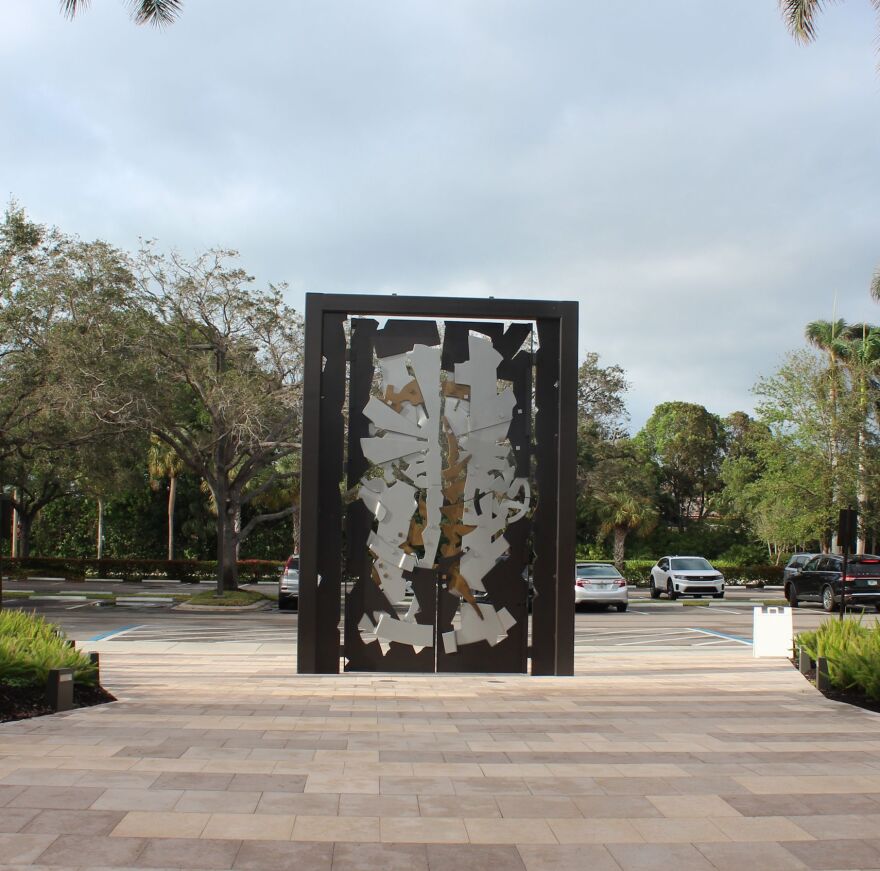Long before patrons step inside Naples’ Baker Museum of Art, they’re treated to nearly a dozen magnificent works of art, free of charge.
“This season, we’re really excited to debut an expanded commitment to outdoor sculpture both on the Artis— Naples cultural campus and on the adjacent property that’s actually owned and managed by the Pelican Bay Foundation,” Gallery Director Courtney McNeil explained.
The Baker Museum partnered with the Pelican Bay Foundation to create a sculpture walk along the sidewalk across the street from the Hayes Hall and museum entrances on Pelican Bay Boulevard.
“This includes some highlights from the permanent collection that had not been on view for a while, including two really fantastic kinetic sculptures by George Rickey [an American kinetic sculptor known for geometric abstractions, often large-scale, engineered to move in response to air currents], and it includes a couple of really lovely loaned sculptures that we’ve been able to borrow thanks to the generosity of some private collectors in the area by artists like Albert Paley and John Henry,” said McNeil.

The expanded presence of outdoor sculptures furthers the Baker Museum’s commitment to make art accessible to the entire community, not just paying patrons.
“I love the idea that somebody could feel like seeing some art on their way home from the beach, and they could just stop and take a little stroll and experience this truly world-class sculpture outdoors right here in Naples,” said McNeil.
Plaques at the base of each sculpture provide information about the artwork and its creator.
“Our wonderful docents lead a walking tour every Thursday from November through the springtime that is specifically focused on outdoor sculpture both on the campus and off the campus,” McNeil added.
The tours last about an hour, but they can go longer if the tour takers are engaged or inquisitive. They typically end at Heidi’s Place, an outdoor café that’s in the Norris Garden near the Dale Chihuly “Red Reeds.”

MORE INFORMATION:

The Paley Gates are unquestionably the signature piece in the Baker Museum’s outdoor collection. They are an exceptional example of the unique portals, passageways and thresholds long associated with Albert Paley. The gates stand 16 feet tall and are 10 feet wide. Endowed by Michael and Deborah Stephens, the steel, bronze and stainless-steel gates were installed in 2000.
Paley also created ornate handles for the lobby doors of Hayes Hall. Known for his inventive and novel approach to both metalsmithing and jewelry design, Paley cut Hayes Hall’s door handles in the form of a bronze ribbon that both commemorates events at the center and suggests an experience in time. A fallen piece of ribbon or banner is a recurring theme in the sculptures Paley crafts as rites of passage for visitors entering a building.

Compliments of Bob and Terry Edwards, Paley’s 2009 Corten steel sculpture “Stance” is part of the Pelican Bay Foundation sculpture trail on the northwest corner of Pelican Bay Boulevard and Ridgewood.
Over the past four decades, Albert Paley has created monumental site-specific metal assemblages that place him not only in the forefront of contemporary sculpture, but also in the vanguard among artists working in the new, genre-defying area that has been called “archisculpture.” Paley goes beyond creating sculptures that stand as isolated works of art. His sculptures enhance the spaces in which they are placed and, in return, are enhanced by those spaces. He has established himself as an artist who constantly pushes boundaries, questions old categories and redefines himself in his own distinctive idiom, at once visionary and persuasively tangible.
Paley emerged in the mid-1960s as an artist goldsmith, and within a decade he became involved with the forging of steel. He is a long-standing leader in the metal sculpture arena, where he is widely recognized for evolving blacksmithing into the realm of public art and commissions. He has continually pushed the boundaries of his work, its process and materials through several contexts.
Forging steel in a form of plasticity and pliability, Paley addresses the transformational change of the material through tapering, swaging, splitting, upsetting and punching. The result is sculpture developed of organic form analogous to processes seen in nature, such as the development of organic form in response to gravity with the emphasis on transition through the quality of line, and his use of steel has been described as industrial poetry.
Commissioned by both public institutions and private corporations, Paley has completed dozens of site-specific works. Some notable examples are the Portal Gates for the Renwick Gallery of the Smithsonian Institution in Washington D.C.; “Synergy,” a ceremonial archway in Philadelphia; the Portal Gates for the New York State Senate Chambers in Albany; “Sentinel,” a monumental plaza sculpture for Rochester Institute of Technology; as well as a 65-foot sculpture for the entry court of Bausch and Lomb’s headquarters in Rochester, N.Y.
Pieces by Albert Paley can be found in the permanent collections of many major museums including the Metropolitan Museum of Art in New York, the Museum of Fine Arts in Boston, the Museum of Fine Arts in Houston, and the Victoria and Albert Museum in London.
Broadly published and an international lecturer, Paley received both his BFA and MFA from the Tyler School of Art in Philadelphia. He received honorary doctorates from the University of Rochester in 1989, the State University of New York at Brockport in 1996, and St. Lawrence University, in Canton, New York, in 1997. He also holds an endowed chair at the Rochester Institute of Technology.

Another artwork appearing on The Baker Museum sculpture trail is John Henry’s bright yellow enameled aluminum sculpture “Arris II.”
It is also on loan from local collectors Bob and Terry Edwards.
Henry died in 2022. Known worldwide for his large-scale public works of art, his sculptures grace numerous important museums, corporate, public and private collections as well as the collections of many American cities and states. His works are also prominently exhibited in the public collections of various European and Asian municipalities.

Henry’s works range in scale from small tabletop pieces to some of the largest contemporary metal sculptures in the world.
He attended the University of Kentucky, University of Chicago and the Art Institute of Chicago, where he received a Ford Foundation grant, the Edward L Ryerson Fellowship and earned a BFA. He received an Honorary Doctor of Arts from the University of Kentucky in 1996.
As a visiting professor of sculpture, Henry taught at the University of lowa, University of Wisconsin, University of Chicago and the School of the Art Institute of Chicago.
In 2002, Henry received the Governor’s National Award in the Arts from the State of Kentucky and in 2004, the Mayor’s Award of Distinction in the Arts from the City of Chattanooga. Other honors included recognition on the floor of the Tennessee State Senate in 2004 and the 2005 honorary renaming of North Cermak Road “John Henry Way” by the City of Chicago in recognition of his contributions to public art on the local and national levels.

The Baker Museum sculpture trail also features Manolo Valdes’ 2003 bronze “Dama III, which was gifted to The Baker Museum in 2013 by Patty and Jay Baker, Bob and Terry Edwards and Bruce and Cynthia Sherman.
Manolo Valdés is a painter, sculptor, and printmaker born in Valencia, Spain in 1942. He is best known for his association with the artistic group known as Equipo Crónica.
Valdés studied at the San Carlos Academy of Fine Arts, and he pioneered the Pop Art movement of the 1960s in Spain. His work is included in public collections around the world, such as the Centre Georges Pompidou in Paris and the Musée Picasso in Antibes, France, the Museo de Arte Contemporáneo in Seville, Spain, the Kunstmuseum in Berlin, the Metropolitan Museum of Art and the Museum of Modern Art in New York, among many others.

Positioned in front of Hayes Hall is Arik Levy’s 2023 artwork RockGrowth370, a mirror-polished, marine-grade stainless steel modernist sculpture.

“Emphasizing elegance, balance and minimalism, the sculptures and outdoor installations of internationally renowned, Paris-based artist Arik Levy (Israel, b. 1963) address the viewer in ways that are equally cerebral and sensuous,” states The Baker Museum’s website. “Using robust materials, such as mirrored marine-grade stainless steel or powder-coated steel, which he finishes with great precision, the artist creates biomorphic forms that invite reflection and contemplation.”
For over 15 years, Levy has been investigating the relationships between humans, social codes, nature, feelings, and science. “With a sophisticated knowledge and understanding of sculptural traditions, he is a technologist as much as he is an artist,” the website reads. “Levy thinks in form, volume, skin, texture and material properties. He manipulates and develops cutting-edge fabrication techniques to propel his ongoing creative investigation and artistic exploration.”
Levy’s innate scientific and poetic acumen, mixed with an interest in innovation, simplicity and experimentation, allows him to translate social and emotional conceptual narratives into sculptures and experiences, both in urban and natural environments. Evoking minerals, arboreal structures, rocks and other forms, Levy’s works exist as monuments that reflect and celebrate the geometry of nature, serenely owning the spaces they occupy.







